Effect of Exposure to High Temperature on the Mechanical Properties of SIFRCCs
Abstract
1. Introduction
2. Materials and Methods
2.1. Used Materials
2.2. Mixing and Fabrication of the Specimens
2.3. Experimental Method
3. Results and Discussion
3.1. Compressive Strength
3.2. Flexural Strength and Flexural Toughness
4. Conclusions
- The experimental results showed that the flexural strength at a high temperature for 1.0% polymer content was the highest at 53.8 MPa, and the resistance to bending was desirable. The average flexural strength at 0.5% was 47.5 MPa and the flexural strength at 1.5% was 49.1 MPa. When compared to 0% polymer content, the flexural strength did not have more difference that with varying content.
- A comparative analysis of the compressive strength characteristics by polymer incorporation rate after high temperature exposure showed that the compressive strength was higher at 0.5% polymer than that at 0%.
- The experimental results showed that the flexural strength decreased by approximately 40% to 50% when compared to the bending strength before high-temperature exposure. The voids that were formed by melting the polymer reduced the internal water vapor pressure and strength, owing to the chemical reaction of the cement mortar at the high temperature.
- After high temperature exposure, the flexural strength of conventional SIFRCCs and the polymer contain SIFRCCs was measured, which showed a decrease in flexural strength due to the interaction of the high-mixed steel fibers and polymer in the cement mortar. A greater chance of decreasing the strength of concrete existed if exposed to high temperature because of the passes of free water through pores created by melting of polymer.
- The adding up to 1.5% of polymer powder can reduce the failure rate of the SIFRCCs structure, owing to an unexpected load, such as fire and explosion.
- Increasing the amount of polymer decreases the compressive and flexural strength of SIFRCCs after exposure to high temperatures, because the polymer creates capillary pores due to melting and burning when exposed to high temperature.
Author Contributions
Funding
Conflicts of Interest
References
- Buchanan, A.H. Structural Design for Fire Safety; Wiley: Chichester, NY, USA, 2001. [Google Scholar]
- Kim, S.; Jung, H.; Kim, Y.; Park, C. Effect of steel fiber volume fraction and aspect ratio type on the mechanical properties of SICON-based HPFRCC. Struct. Eng. Mech. 2018, 65, 167–171. [Google Scholar]
- Xiong, M.-X.; Richard Liew, J.Y. Spalling behavior and residual resistance of fibre reinforced ultra-high performance concrete after exposure to high temperatures. Mater. Constr. 2015, 65, 1–10. [Google Scholar] [CrossRef]
- Ahsanollah, B.; Çağlar, Y.; Hüseyin, Y.; Halit, Y. Flexural performance of SIFCON composite subjected to high temperature. Constr. Build. Mater. 2016, 104, 99–108. [Google Scholar]
- Novák, J.; Kohoutková, A. Fire response of hybrid fiber reinforced concrete to high temperature. Procedia Eng. 2017, 172, 784–790. [Google Scholar] [CrossRef]
- Çavdar, A. A study on the effects of high temperature on mechanical properties of fiber reinforced cementitious composites. Compos. B Eng. 2012, 43, 2452–2463. [Google Scholar] [CrossRef]
- Jin, C.L.; Kang, H.T. Mechanism of PVA fibers in mitigating explosive spalling of engineered cementitious composite at elevated temperature. Cem. Concr. Compos. 2018, 93, 235–245. [Google Scholar]
- Sahmaran, M.; Lachemi, M.; Li, V.C. Assessing mechanical properties and microstructure of fire-damaged engineered cementitious composites. ACI Mater. J. 2010, 107, 297–304. [Google Scholar]
- Kanda, T.; Lin, Z.; Li, V.C. Tensile stress-strain modeling of pseudo strain-hardening cementitious composites. J. Mater. Civ. Eng. 2000, 12, 147–156. [Google Scholar] [CrossRef]
- Bhat, P.S.; Chang, V.; Li, M. Effect of elevated temperature on strain-hardening engineered cementitious composites. Constr. Build. Mater. 2014, 69, 370–380. [Google Scholar] [CrossRef]
- Yu, K.; Lu, Z.; Yu, J. Residual compressive properties of strain-hardening cementitious composite with different curing ages exposed to high temperature. Constr. Build. Mater. 2015, 98, 146–155. [Google Scholar] [CrossRef]
- Muhammad, A.; Xiaomeng, H.; Wenzhong, Z.; Raja, R.H. High temperature and residual properties of reactive powder concrete–a review. J. Constr. Build. Mater. 2017, 147, 339–351. [Google Scholar]
- Wenzhong, Z.; Baifu, L.; Ying, W. Stress–strain relationship of steel-fibre reinforced reactive powder concrete at elevated temperatures. Mater. Struct. 2015, 48, 2299–2314. [Google Scholar]
- Li, X.; Bao, Y.; Xue, N.; Chen, G. Bond strength of steel bars embedded in high-performance fiber-reinforced cementitious composite before and after exposure to elevated temperatures. Fire Saf. J. 2017, 92, 98–106. [Google Scholar] [CrossRef]
- Poon, C.S.; Shui, Z.H.; Lam, L. Compressive behavior of fibre reinforced high-performance concrete subjected to elevated temperatures. Cem. Concr. Res. 2004, 34, 2215–2222. [Google Scholar] [CrossRef]
- Hu, Y.-J.; Jian, C.; Liu, W.; Yu, Q.-Q.; Zhou, Y.-L. Degradation of the In-plane Shear Modulus of Structural BFRP Laminates Due to High Temperature. Sensors 2018, 18, 3361. [Google Scholar] [CrossRef] [PubMed]
- Kim, S.; Kim, D.J.; Kim, S.-W.; Park, C. Tensile Behavior Characteristics of High-Performance Slurry-Infiltrated Fiber-Reinforced Cementitious Composite with respect to Fiber Volume Fraction. Materials 2019, 12, 3335. [Google Scholar] [CrossRef]
- Kim, S.; Park, C. Flexural Behavior Characteristics of High Performance Slurry Infiltrated Fiber Reinforced Cementitious Composite with Respect to Exposure to High Temperature. J. Korea Concr. Inst. 2019, 31, 139–146. [Google Scholar] [CrossRef]
- Sclofani, D.A.S.; Contrafatto, L. Experimental Behaviour of Polyvinyl-Alcohol Modified Concrete. Adv. Mater. Res. 2013, 687, 155–160. [Google Scholar] [CrossRef]
- Ding, Y.; Azevedo, C.; Aguiar, J.B.; Jalali, S. Study on residual behaviour and flexural toughness of fibre cocktail reinforced self compacting high performance concrete after exposure to high temperature. Constr. Build. Mater. 2012, 26, 21–31. [Google Scholar] [CrossRef]
- Cho, H.-M.; Kim, S.-W.; Song, J.-H.; Park, H.-M.; Park, C.-W. Experimental Study on Mechanical Properties of Carbon-Capturing Concrete Composed of Blast Furnace Slag with Changes in Cement Contents and Exposure. Int. J. Highw. Eng. 2015, 17, 41–51. [Google Scholar] [CrossRef]
- Steel Fiber. Available online: http://www.kosteel.co.kr/kor/WeProvide/Product2.aspx?pCode=SFRC_bundrex (accessed on 5 November 2012).
- Polymer. Available online: https://www.wacker.com/h/en-us/c/vinnapas-418/p/000008936 (accessed on 5 November 2019).
- Kim, S.-W.; Cho, H.-M.; Lee, H.-Y.; Park, C.-W. Flexural Performance Characteristics of High Performance Slurry Infiltrated Fiber Reinforced Cementitious Composite according to Fiber Volume Fraction. J. Korea Inst. Struct. Maint. Insp. 2015, 19, 109–115. [Google Scholar]
- Kim, S.W.; Park, C.W.; Kim, S.W.; Cho, H.M.; Jeon, S.P.; Ju, M.K. Optimum Mix Proporations of In-fill Slurry for High Performance Steel Fiber Reinforced Cementitious Composite. J. Korean Rec. Conct. Resour. Inst. 2014, 2, 196–201. [Google Scholar]
- American Society for Testing and Materials (ASTM). Standard Test Method for Flexural Performance of Fiber-Reinforced Concrete (Using Beam with Third-Point Loading). In ASTM C 1609; American Society for Testing and Materials: West Conshohocken, PA, USA, 2006. [Google Scholar]
- American Society for Testing and Materials (ASTM). Standard Test Method for Compressive Strength of Cylindrical Concrete Specimens. In ASTM C39; American Society for Testing and Materials: West Conshohocken, PA, USA, 2012. [Google Scholar]
- Choi, H.-K.; Bae, B.-I.; Choi, C.-S. Mechanical Characteristics of Ultra High Strength Concrete with Steel Fiber Under uniaxial Compressive Stress. J. Korea Concr. Inst. 2015, 27, 521–530. [Google Scholar] [CrossRef]
- Propovics, S. A Numerical Approach to the Complete Stress-Strain Curve of Concrete. Cem. Concr. Res. 1973, 3, 583–599. [Google Scholar] [CrossRef]
- Sargin, M. Stress-Strain Relationship for Concrete and the Analysis of Structural Concrete Sections; University of Waterloo: Waterloo, ON, Canada, 1971; p. 167. [Google Scholar]
- Collins, M.P.; Mitchell, D.; Macgregor, J.G. Structural Design Considerations for High-Strength Concrete. Concr. Int. Des. Const. 1993, 15, 27–34. [Google Scholar]
- Carreira, D.J.; Chu, K.D. Stress-Strain Relationship for Plain Concrete in Compression. ACI J. 1985, 82, 797–804. [Google Scholar]
- Wee, T.H.; Chin, M.S.; Mansur, M.A. Stress-Strain Relationship of High-Strength Concrete in Compression. J. Mater. Civ. Eng. 1996, 8, 70–76. [Google Scholar] [CrossRef]
- Graybeal, B.A. Compressive Behavior of Ultra-High-Performance Fiber-Reinforced Concrete. ACI Mater. J. 2007, 104, 146–152. [Google Scholar]
- KS F 2257-1. Method of Fire Resistance Test for Elements of Building Construction—General Requirements; Korean Standard Association: Seoul, Korea, 2014. [Google Scholar]
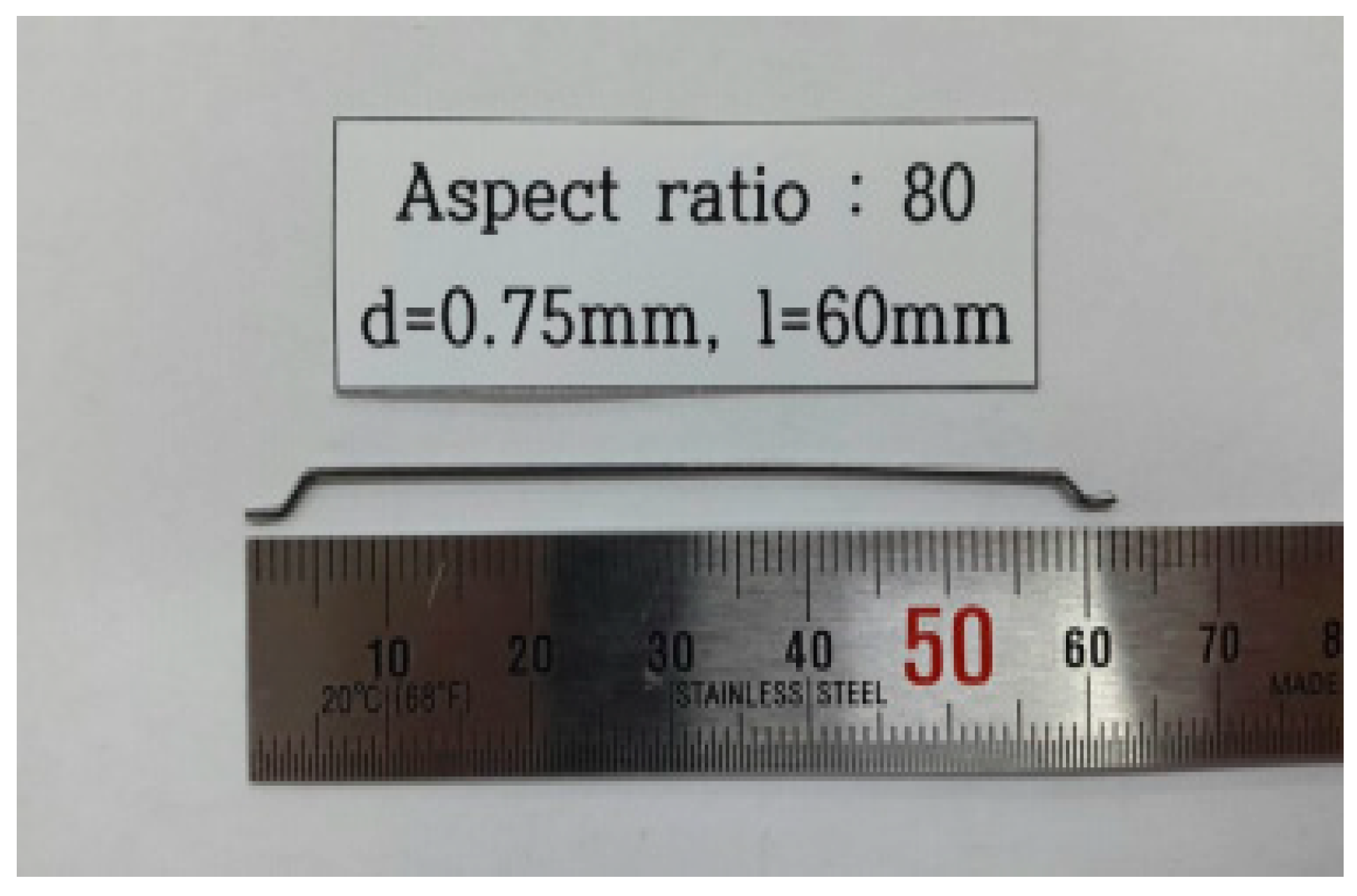
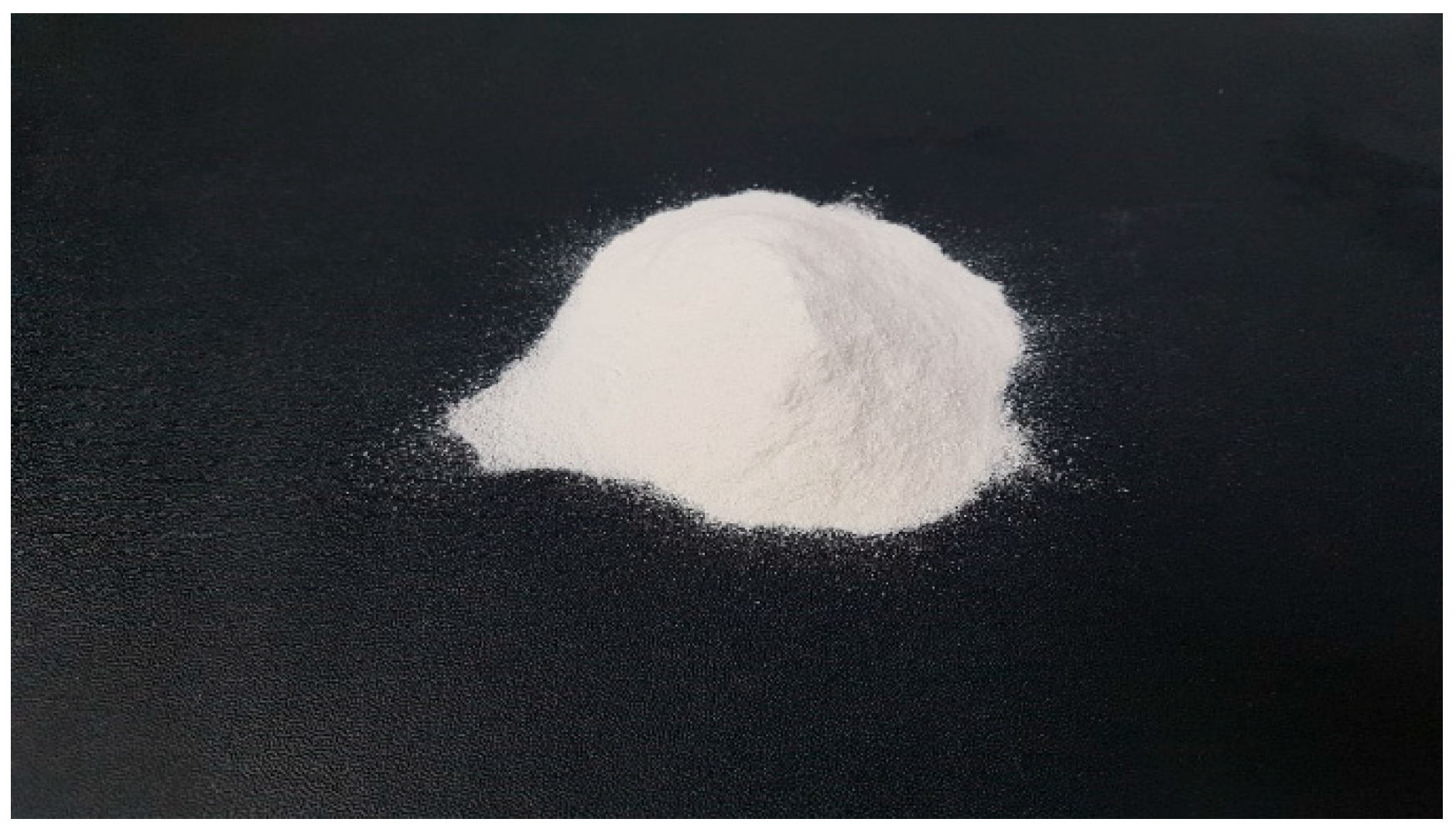
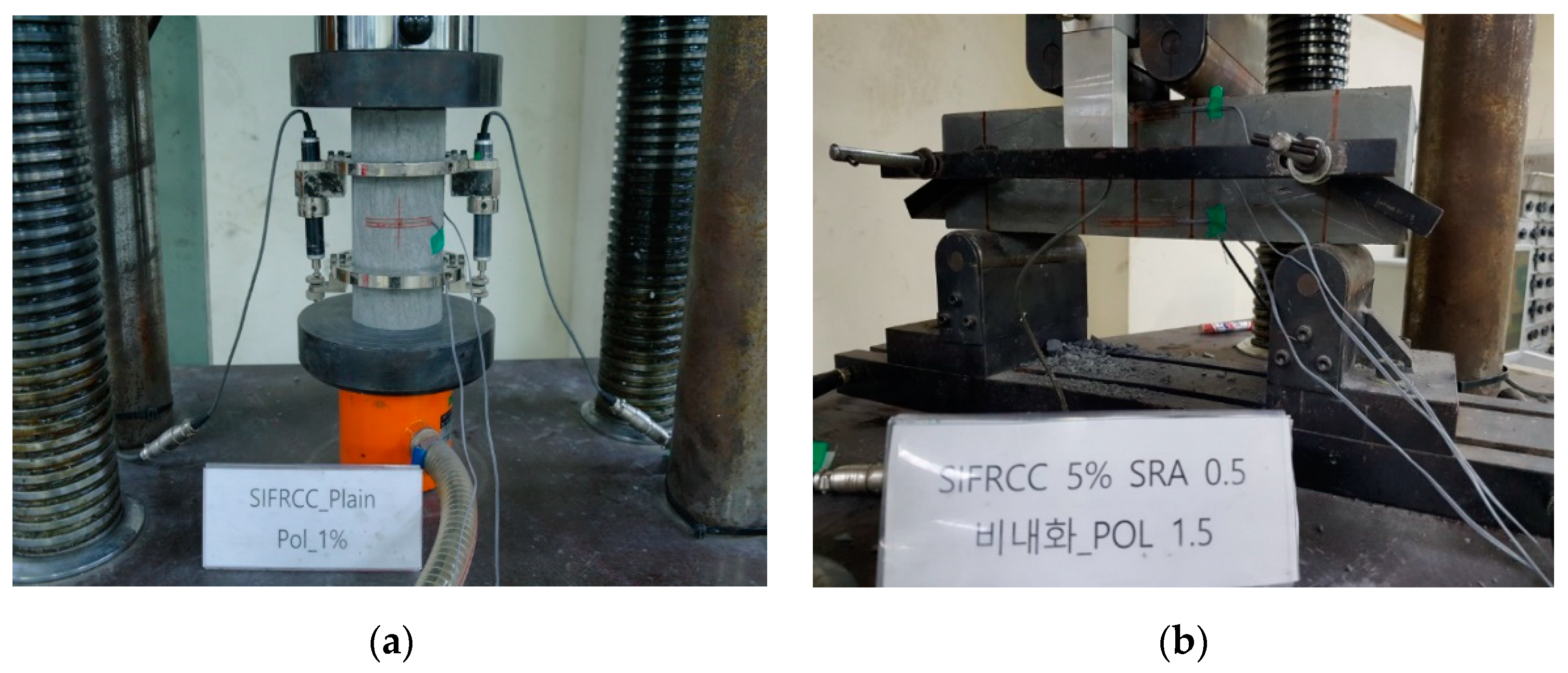
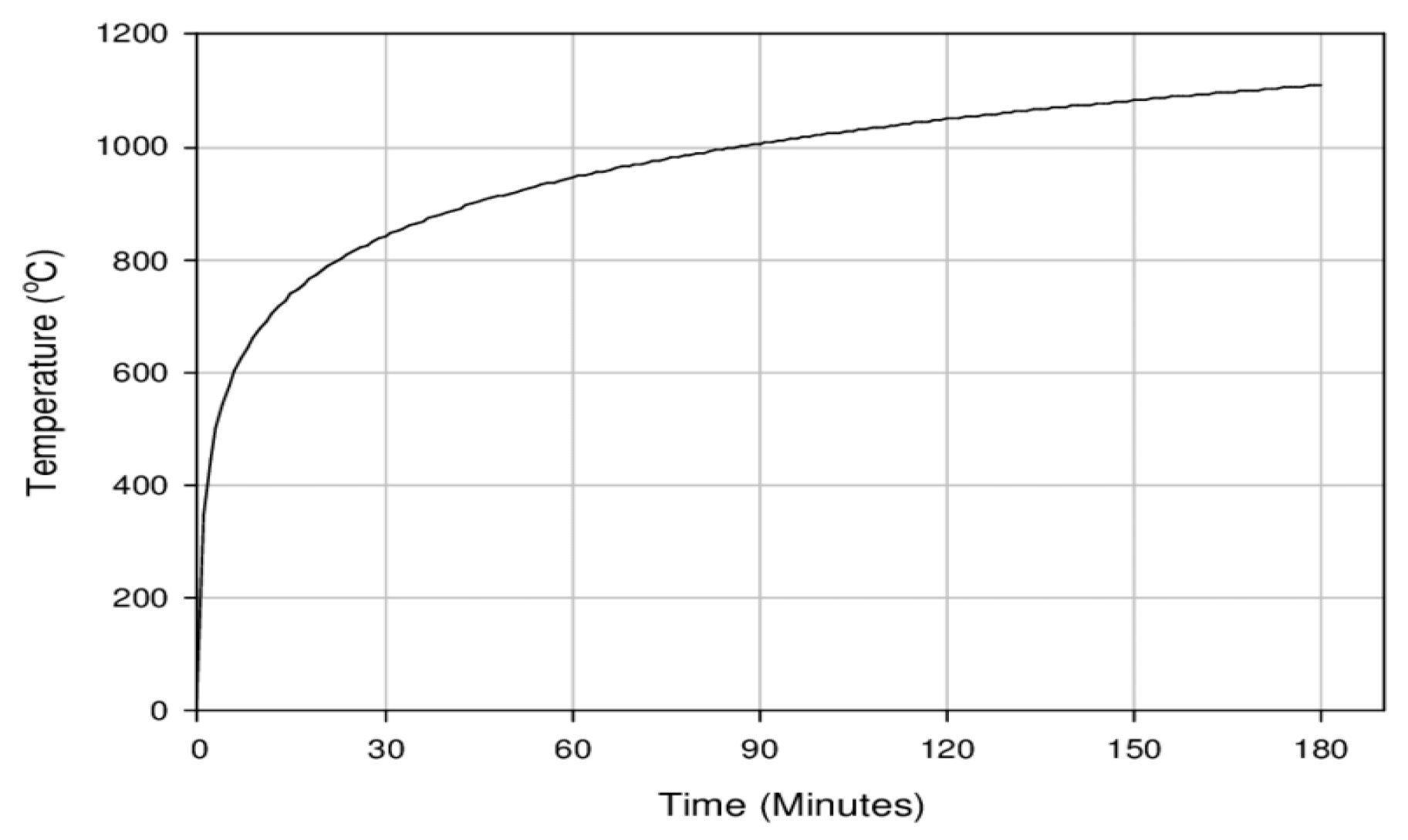
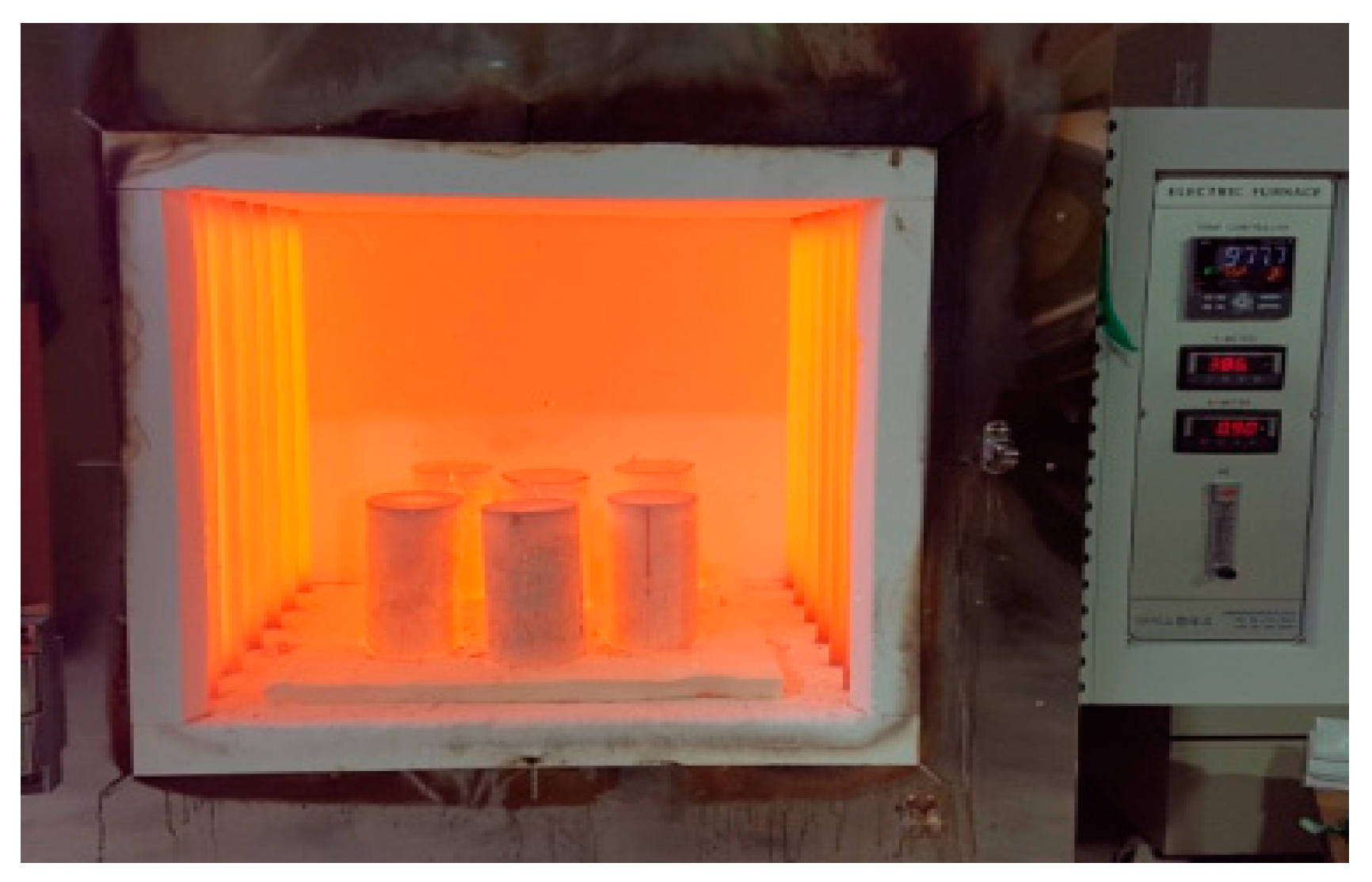
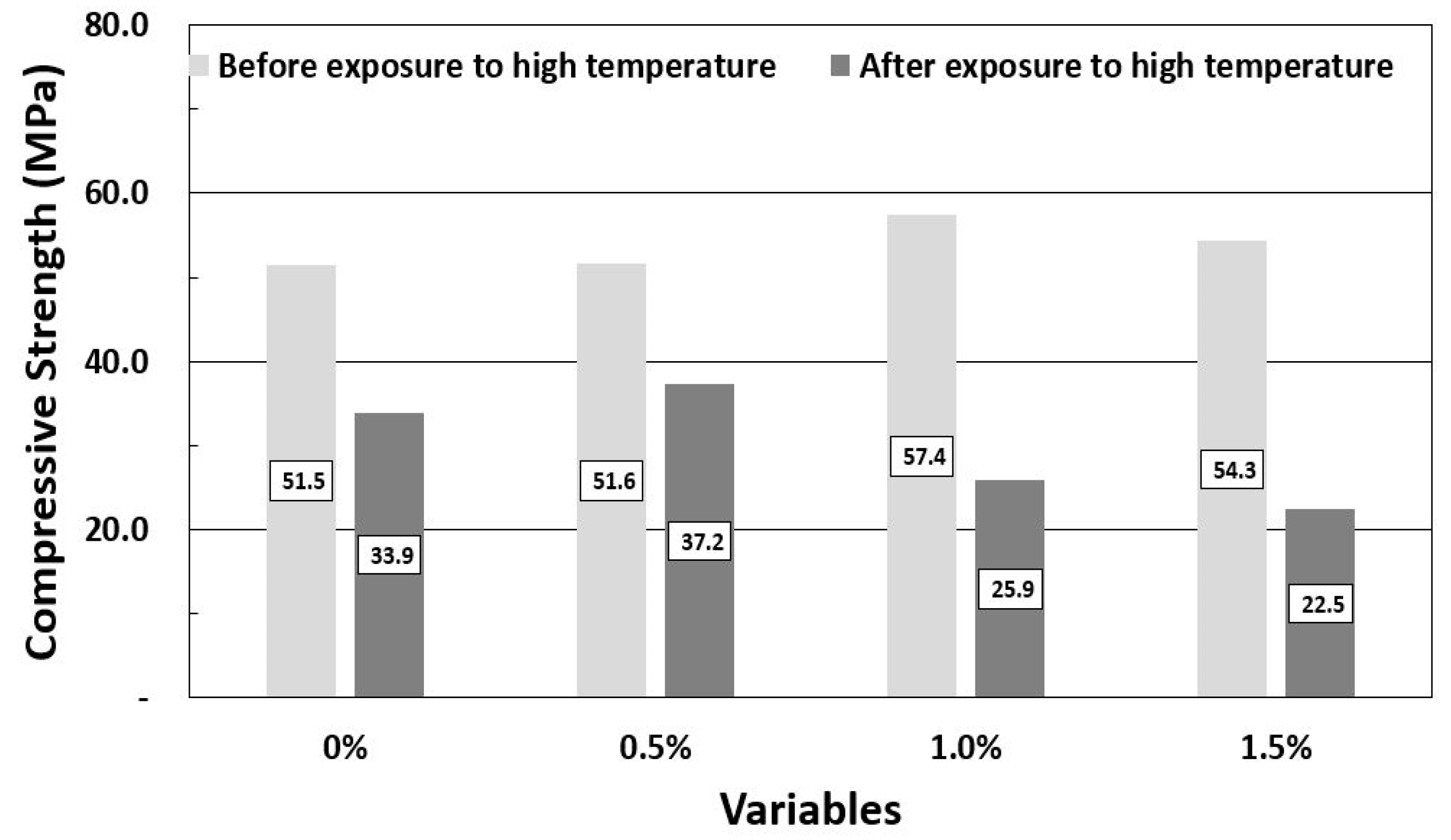
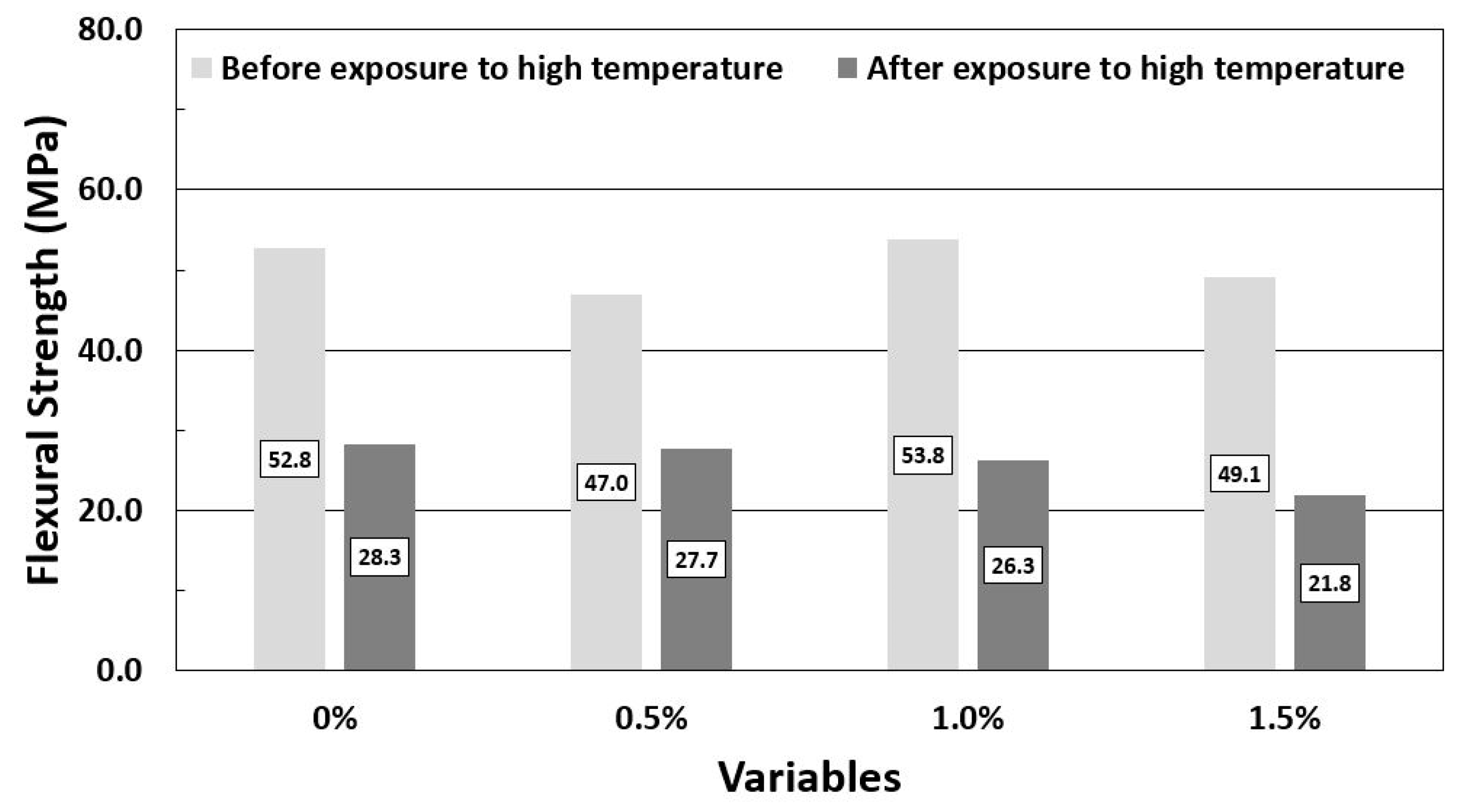
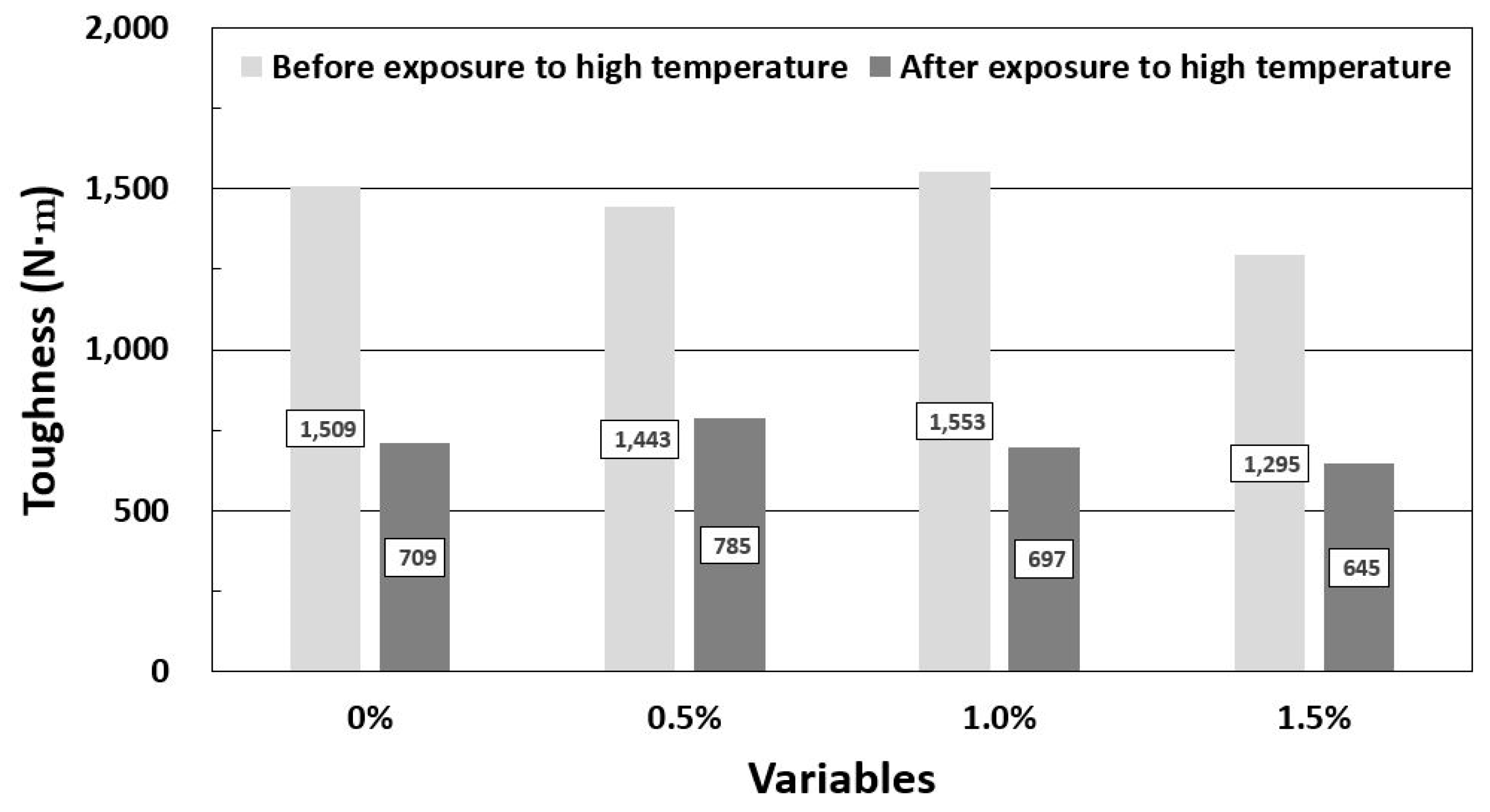
| W/B | OPC | Silica Fume | Polymer (Vf, %) | FA | HRWR | SRA | Steel Fiber (Vf, %) |
|---|---|---|---|---|---|---|---|
| 0.35 | 1 | 0.15 | 0 0.5 1.0 1.5 | 0.5 | 0.025 | 0.005 | 5 |
© 2020 by the authors. Licensee MDPI, Basel, Switzerland. This article is an open access article distributed under the terms and conditions of the Creative Commons Attribution (CC BY) license (http://creativecommons.org/licenses/by/4.0/).
Share and Cite
Kim, S.; Oli, T.; Park, C. Effect of Exposure to High Temperature on the Mechanical Properties of SIFRCCs. Appl. Sci. 2020, 10, 2142. https://doi.org/10.3390/app10062142
Kim S, Oli T, Park C. Effect of Exposure to High Temperature on the Mechanical Properties of SIFRCCs. Applied Sciences. 2020; 10(6):2142. https://doi.org/10.3390/app10062142
Chicago/Turabian StyleKim, Seungwon, Topendra Oli, and Cheolwoo Park. 2020. "Effect of Exposure to High Temperature on the Mechanical Properties of SIFRCCs" Applied Sciences 10, no. 6: 2142. https://doi.org/10.3390/app10062142
APA StyleKim, S., Oli, T., & Park, C. (2020). Effect of Exposure to High Temperature on the Mechanical Properties of SIFRCCs. Applied Sciences, 10(6), 2142. https://doi.org/10.3390/app10062142





